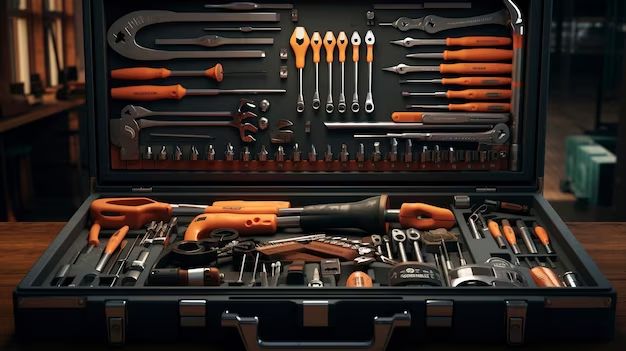Having a proper storage system for power tools is crucial for both professionals and hobbyists. Proper storage helps protect your investment, keeps tools organized and accessible, and extends their lifespan. In this comprehensive guide, we will explore the best practices for storing all types of power tools.
Page Contents
Cordless Power Tools
Cordless power tools run on rechargeable lithium-ion battery packs. Some key factors to consider when storing cordless tools include:
Batteries
Lithium-ion batteries slowly self-discharge when not in use. Leaving them stored long-term at full charge can damage their capacity and lifespan. Best practice is to discharge batteries to around 40% before storage. Store batteries seperately from tools in a cool, dry place. Some chargers have storage modes that automatically discharge batteries to an ideal level.
Temperature
Extreme cold and heat can damage lithium-ion batteries. Store tools and batteries in a climate controlled space between 50-80 degrees Fahrenheit.
Humidity
Humidity can corrode electrical components in cordless tools. Store in a dry area with a humidity level between 45-65%. Use moisture absorbing silica packets if needed.
Charging
Charge cordless tools every 3-6 months during storage to maintain optimal battery health. This helps prevent over-discharge and keeps the batteries balanced.
Cases
Store cordless tools in their original cases or bags. This protects them from damage and keeps all components together.
Corded Power Tools
Corded power tools run on AC power via an electrical cord. Key storage considerations include:
Location
Store corded tools in a clean, dry area protected from the elements. Garages, basements, and storage rooms work well. Avoid damp areas with pests like attics or sheds.
Temperature & Humidity
As with cordless tools, aim to store corded tools in a space with moderate temperature between 50-80°F and 45-65% humidity. Protect from moisture, condensation, and humidity.
Cases
Store corded tools in their cases or original packaging to prevent damage. This also keeps accessories organized.
Cords
Wind cords loosely when storing tools. Do not wrap tightly around the tool. Tight wrapping can damage wiring over time.
Maintenance
Before storage, clean tools and do any required maintenance like lubricating or replacing worn parts. This prevents issues when they are taken out of storage.
Where to Store Power Tools
The optimal storage location depends on your space available. Here are some of the most common options:
Tool Chest
Tool chests provide enclosed storage that protects contents from dust and humidity. Chests feature drawers of different sizes to accommodate tools and accessories. They allow easy portability and access.
Pegboard
Pegboards mounted on walls allow you to neatly hang tools for visibility and access. Make sure to arrange heavier tools on bottom rows. Use outlines for each tool so you can easily spot missing items.
Cabinet
Storage cabinets provide enclosed storage similar to chests. Look for sturdy cabinets with full-extension drawers for easy access. Store batteries and accessories in separate drawers.
Shelving
Open shelving units are good for bulky tools that won’t fit in drawers. Ensure shelves are sturdy enough to handle weight. Avoid stacking tools on top of each other.
Workbench
Your workbench can double as storage by mounting a pegboard above it and including lower shelves and drawers. Keep your most-used tools easily accessible at the bench.
Garage Wall
Utilize empty garage wall space by mounting pegboards, slatwall panels, shelves, and cabinet storage. Arrange tools categorically for easy access.
Tips for Organizing Tools
Proper organization of your power tools is just as important as storage. Here are some key tips for keeping tools neat and accessible:
- Group tools categorically – keep all drilling tools together, cutting tools together, etc.
- Arrange by most frequently used tools.
- Heavier tools should be stored low and lighter tools up high.
- Utilize drawer inserts and foam cutouts to create custom spots for each tool.
- Label storage spots so tools are returned correctly.
- Store all accessories with their tools – bits, blades, batteries, chargers, cases, etc.
Preventing Tool Damage and Corrosion
Utilize these tips to keep tools from being damaged or corroding during storage:
- Clean tools before storing to remove dirt, dust, oils, and residue.
- Apply a corrosion preventative spray to metal components.
- Lubricate moving parts according to manufacturer instructions.
- Replace worn brushes, bearings, belts, or other parts.
- Cover with a tarp or store in cases away from sunlight and humidity.
- Add moisture absorbing silica gel packets if storing in humid environments.
- Avoid stacking or crowding tools tightly together in storage.
Long Term Tool Storage
For storing tools more than 3-6 months:
- Discharge and remove lithium-ion batteries from cordless tools.
- Periodically charge and discharge batteries every 3 months.
- Wrap cords loosely before storing corded tools.
- Apply plastic caps to protect machined surfaces from corrosion.
- Coat metal parts with quality rust preventative or machine oil.
- Seal tools in plastic bags or storage containers.
- Prevent dust buildup by storing tools in cabinets or chests.
What Not to Do
Some common tool storage mistakes to avoid:
- Leaving batteries stored long term at full charge.
- Letting lithium-ion batteries drain completely before storage.
- Exposing tools to temperature and humidity extremes.
- Allowing dust, dirt, and residue to accumulate.
- Stacking tools haphazardly on shelves or workbenches.
- Wrapping cords tightly around tools when storing.
- Storing tools near solvents, chemicals, or gasoline.
Conclusion
Properly storing power tools involves carefully considering factors such as temperature, humidity, battery health, preventing corrosion, and organization. Take inventory of your tools and usage patterns. Provide an easily accessible yet protected storage space tailored to your specific needs. With proper storage and care, your power tool investment will last for years to come.
